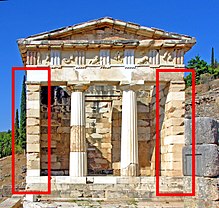
An anta (pl. antæ, antae, or antas; Latin, possibly from ante, "before" or "in front of"), or sometimes parastas (pl. parastades), is a term in classical architecture describing the posts or pillars on either side of a doorway or entrance of a Greek temple – the slightly projecting piers which terminate the side walls (of the naos).[1] Antae are formed either by thickening the walls or by attaching a separate strip and can serve to reinforce brick walls, as in the Heraeum of Olympia (c. 600 BCE).[2]
Antae differ from the pilaster, which is purely decorative, and does not have the structural support function of the anta.